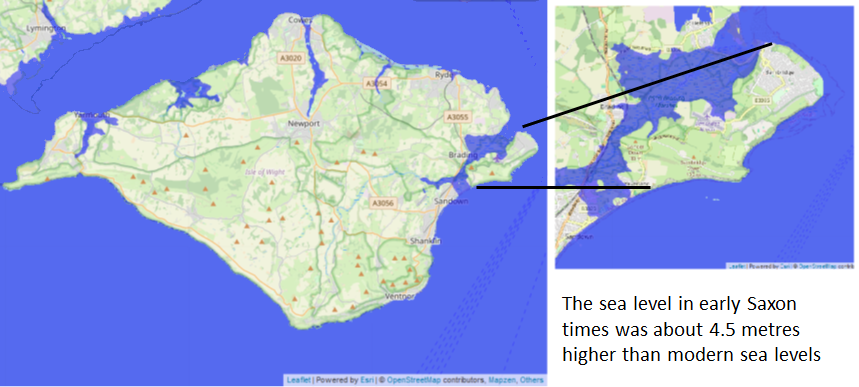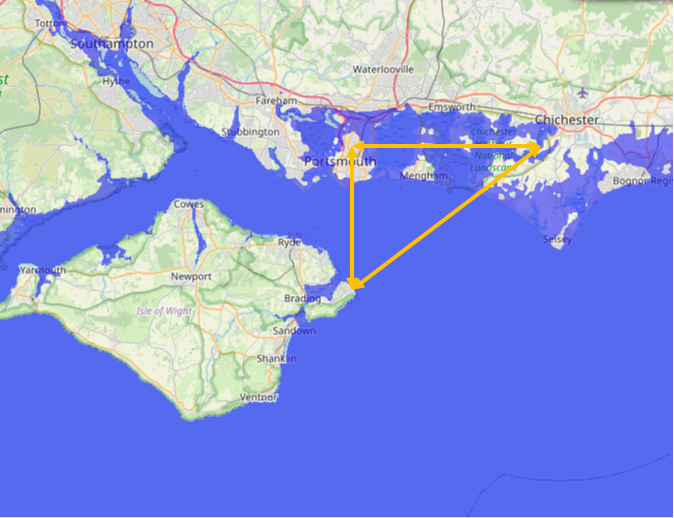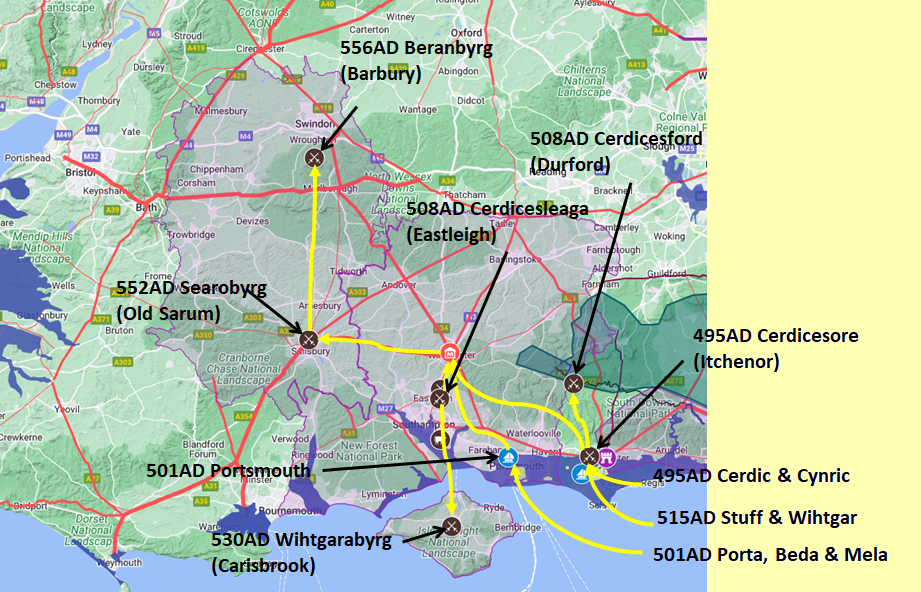|
 | Anglo Saxon History |  | |
| | Anglo Saxon Chronicles - 514AD - Stuff and Wihtgar |
|---|
| | The entry from the Chronicles |
|---|
Original text
Her cuomon Westseaxe in Bretene mid .iii. scipum in þa stowe þe is gecueden Cerdicesora, ⁊ Stuf ⁊ Wihtgar, ⁊
fuhton wiþ Brettas ⁊ hie gefliemdon.
Translation
514AD. This year came the West-Saxons into Britain, with three ships, at the place that is called Cerdic's-ore. And
Stuff and Wihtgar fought with the Britons, and put them to flight.
| | An Interpretation of the Chronicles |
|---|
Stuff and Whitgar land at Cerdicesora (Itchenor) with three ships so probably only have about 60 men.
They fight the Welsh sometime later during 514AD.
We know that in 530AD Cerdic and Cynric took Wihtgarabyrg which consists of three snippets 'Wiht' named after the
isle of Wight 'gara' which means 'a corner of land' and 'byrg' a burh 'a castle', hence 'the castle on
the edge of the hills on the Isle of Wight' (probably Carisbrook) and later in 534AD they gave the whole of the Isle
of Wight to Stuff and Whitgar.
This implies that Stuff and Whitgar had already landed on the island, but had not been able to take the whole island.
If they landed on the island, there is only one place they could have landed which would have been defendable by their
small force and that is the area around Bembridge which was an island at the time, and would make a good small kingdom.
Bembridge translates from the two Saxon snippets 'Bem' from 'bán' meaning 'bones' and 'bridge' meaning a
bridge, hence 'the bridge of bones', possibly a battle site, this island would have had easy trade routes back to
Port and Portsmouth and to Cerdic and Cynric at Itchenor.
There is also coincidentally an area on Bembridge island called Ethel point, this can be translated from the
Saxon 'eþel' pronounced Ethyl and means 'Fatherland', 'point' is a later Norman addition, so this could
help in the above interpretation.
'Binbridge Isle' is published on John Speeds map of the Isle of Wight from 1611, and although not quite an island on the
map it shows most of the boundary of the island.
Please see our article Landscape - Was the
sea level in Saxon times at Pevensey 4 to 5 metres higher ? that explains the high tide levels in Early Saxon times
and Landscape - High Tide changes in the last 2000 years
|
Possible landing place of Stuff and Whitgar
|
|---|

| | |
|---|
Possible trade routes between Stuff and Whitgar, Port and Cerdic
|
|---|

| | |
|---|
Map showing the Battles of Cerdic, Cynric and the West Saxons
|
|---|

Map generated using Google My Maps 2024 - showing the
Landscape, modern Counties and sea in 477AD
Please Note: this map is my interpretation of the Anglo Saxon Chronicles entries relating to Cerdic, Cynric and the West
Saxons and their take over of Hampshire, the thin purple line shows the modern Hampshire boundary.
The logic for the coastal changes and the Forest of Andredsweald can be viewed on the following pages:
Roman Roads in Britain
The Great Forest of Andredsweald - Anglo
Saxon Chronicles
Landscape - Was the sea level in Saxon times
at Pevensey 4 to 5 metres higher ?
Was the high tide in Saxon times 5 metres higher
? - the Wash
Landscape - The History of the Romney Marsh in
maps(Pre-Roman to Modern times)
Roman Locations that have not been identified and roads that
just terminate
| | |
|---|
| Conclusion |
|---|
The majority of this article is conjecture, but it does seem to fit the history and the landscape, but hopefully this
has given you a different view of the Anglo Saxon Chronicles.
|
|
|
|
|
| |
|
|
Local Interest
Just click an image |
|
|
|
|
|
|
|
|
|
|
|
|
| |
|
|